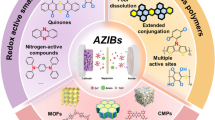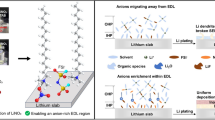Abstract
The electrocatalytic activity of synthesized quasi-spherical Pt nanoparticles (NPs) has been studied, taking as a model the COads electrooxidation reaction in two imidazolium-based ionic liquids such as 1-butyl-3-methylimidazolium bis(trifluoromethylsulfonyl)imide [C4mim+][NTf2 −] and 1-butyl-3-methylimidazolium tetrafluoroborate [C4mim+][BF4 −]. In particular, the effect of (i) water content, (ii) temperature, and (iii) nature of the room-temperature ionic liquid (RTIL) on the electrocatalytic behavior of these Pt NPs has been systematically evaluated. The obtained results show how important are those parameters, since the COads oxidation peak potential exhibits a great sensitivity depending on the water content, temperature, and nature of the RTIL used. Interestingly, the charge density associated with the COads electrooxidation peak strongly depends on the nature of the ionic liquid, which reflects the complexity of this electrocatalytic reaction in this media. Moreover, Pt NP electrocatalyst degradation in those RTILs, considered as a loss of electrochemically active area, has been evaluated and shows high stability despite the extreme potentials afforded in RTILs.









Similar content being viewed by others
References
Hapiot P, Lagrost C (2008) Electrochemical reactivity in room-temperature ionic liquids. Chem Rev 108:2238–2264
Endres F, El Abedin SZ (2006) Air and water stable ionic liquids in physical chemistry. Phys Chem Chem Phys 8:2101–2116
Pandey S (2005) Analytical applications of room-temperature ionic liquids: a review of recent efforts. Anal Chim Acta 556:38–45
Erdem A, Muti M, Mese F, Eksin E (2014) Chitosan-ionic liquid modified single-use sensor for electrochemical monitoring of sequence-selective DNA hybridization. Colloids Surf B 114:261–268
Harun M, Sabri F, Muen I, Ali M, Azlan M, Bahadori L, Low CTJ (2014) Prospects of applying ionic liquids and deep eutectic solvents for renewable energy storage by means of redox flow batteries. Renew Sust Energ Rev 30:254–270
De Souza RF, Padilha JC, Gonçalves RS, Dupont J (2003) Room temperature dialkylimidazolium ionic liquid-based fuel cells. Electrochem Commun 5:728–731
Galinski M, Lewandowski A, Stepniak I (2006) Ionic liquids as electrolytes. Electrochim Acta 51:5567–5580
O’Mahony AM, Silvester DS, Aldous L, Hardacre C, Compton RG (2008) Effect of water on the electrochemical window and potential limits of room-temperature ionic liquids. J Chem Eng Data 53:2884–2891
Darling HE (1964) Conductivity of sulfuric acid solutions. J Chem Eng Data 9:421–426
Rhodes FH, Barbour CB (1923) The viscosities of mixtures of sulfuric acid and water. Ind Eng Chem 15:850–852
Wen Z, Liu J, Li J (2008) Core/shell Pt/C nanoparticles embedded in mesoporous carbon as a methanol-tolerant cathode catalyst in direct methanol fuel cells. Adv Mater 20:743–747
Song C (2002) Fuel processing for low-temperature and high-temperature fuel cells: challenges, and opportunities for sustainable development in the 21st century. Catal Today 77:17–49
Liu R, Duay J, Lee SB (2011) Heterogeneous nanostructured electrode materials for electrochemical energy storage. Chem Commun 47:1384–1404
Rigsby MA, Zhou WP, Lewera A, Duong HT, Bagus PS, Jaegermann W, Hunger R, Wieckowski A (2008) Experiment and theory of fuel cell catalysis: methanol and formic acid decomposition on nanoparticle Pt/Ru. J Phys Chem C 112:15595–15601
Neyerlin KC, Srivastava R, Yu C, Strasser P (2009) Electrochemical activity and stability of dealloyed Pt-Cu and Pt-Cu-Co electrocatalysts for the oxygen reduction reaction (ORR). J Power Sources 186:261–267
Solla-Gullón J, Montiel V, Aldaz A, Clavilier J (2000) Electrochemical characterization of platinum nanoparticles prepares by microemulsion: how to clean them without loss of crystalline surface structure. J Electroanal Chem 491:69–77
Sánchez-Sánchez CM, Solla-Gullón J, Vidal-Iglesias FJ, Aldaz A, Montiel V, Herrero E (2010) Imaging structure sensitive catalysis on different shape-controlled platinum nanoparticles. J Am Chem Soc 132:5622–5624
Vidal-Iglesias FJ, Solla-Gullón J, Montiel V, Feliu JM, Aldaz A (2007) Screening of electrocatalysts for direct ammonia fuel cell: ammonia oxidation on PtMe (Me: Ir, Rh, Pd, Ru) and preferentially oriented Pt(100) nanoparticles. J Power Sources 171:448–456
Lou J, Wang L, Mott D, Njoki PN, Lin Y, He T, Xu A, Wanjana BN, Lim IS, Zhong CJ (2008) Core/shell nanoparticles as electrocatalysts for fuel cell reactions. Adv Mater 20:4342–4347
Wang X, You Z, Cheng Y, Sha H, Li G, Zhu H, Sun W (2015) Application of nanosized gold and graphene modified carbon ionic liquid electrode for the sensitive electrochemical determination of folic acid. J Mol Liq 204:112–117
Wang D, Dou W, Zhao G, Chen Y (2014) Immunosensor based on electrodeposition of gold-nanoparticles and ionic liquid composite for detection of Salmonella pullorum. J Microbiol Meth 106:110–118
Zhang D, Chang WC, Okajima T, Ohsaka T (2011) Electrodeposition of platinum nanoparticles in a room-temperature ionic liquid. Langmuir 27:14662–14668
Zhang G, Zhou H, An C, Liu D, Huang Z, Kuang Y (2012) Bimetallic palladium-gold nanoparticles synthesized in ionic liquid microemulsion. Colloid Polym Sci 290:1435–1441
Wang X, Cheng Y, You Z, Sha H, Gong S, Liu J, Sun W (2015) Sensitive electrochemical determination of oxalic acid in spinach samples by a graphene-modified carbon ionic liquid electrode. Ionics 21:877–884
Ghilane J, Lacroix J-C (2013) Formation of a bifunctional redox system using electrochemical reduction of platinum in ferrocene based ionic liquid and its reactivity with aryldiazonium. J Am Chem Soc 135:4722–4728
Hanc-Scherer FA, Sánchez-Sánchez CM, Ilea P, Herrero E (2013) Surface-sensitive electrooxidation of carbon monoxide in room temperature ionic liquids. ACS Catal 3:2935–2938
Herrero E, Alvarez B, Feliu JM, Blais S, Radovic-Hrapovic Z, Jerkiewicz G (2004) Temperature dependence of the COads oxidation process on Pt(111), Pt(100) and Pt(110) electrodes. J Electroanal Chem 567:139–149
Ejigu A, Johnson L, Licence P, Walsh DA (2012) Electrocatalytic oxidation of methanol and carbon monoxide at platinum in protic ionic liquids. Electrochem Commun 23:122–124
Herrero E, Feliu JM, Blais S, Radovec-Hrapovic Z, Jerkiewicz G (2000) Temperature dependence of CO chemisorption and its oxidative desorption on the Pt(111) electrode. Langmuir 16:4779–4783
Ejigu A, Walsh DA (2014) The role of adsorbed ions during electrocatalysis in ionic liquids. J Phys Chem C 118:7414–7422
Yang YY, Zhang LN, Osawa M, Cai WB (2013) Surface-enhanced infrared spectroscopic study of a CO-covered Pt electrode in room-temperature ionic liquid. J Phys Chem Lett 4:1582–1586
Baldelli S (2008) Surface structure at the ionic liquid-electrified metal interface. Acc Chem Res 41:421–431
Aliaga C, Santos CS, Baldelli S (2007) Surface chemistry of room-temperature ionic liquids. Phys Chem Chem Phys 9:3683–3700
Baldelli S (2005) Probing electric field at the ionic liquid-electrode interface using sum frequency generation spectroscopy and electrochemistry. J Phys Chem B 109:13049–13051
Lewandowski A, Waligora L, Galinski M (2009) Ferrocene as reference redox couple for aprotic ionic liquids. Electroanalysis 21:2221–2227
Trasatti S, Petrii OA (1991) Real surface-area measurements in electrochemistry. Pure Appl Chem 63:711–734
Solla-Gullón J, Rodríguez P, Herrero E, Aldaz A, Feliu JM (2008) Surface characterization of Pt electrodes. Phys Chem Chem Phys 10:1359–1373
Solla-Gullón J, Vidal-Iglesias FJ, López-Cudero A, Garnier E, Feliu JM, Aldaz A (2008) Shape-dependent electrocatalysis: methanol and formic acid electrooxidation on preferentially oriented Pt nanoparticles. Phys Chem Chem Phys 10:3689–3698
Widegren JA, Saurer EM, Marsh KN, Magee JW (2005) Electrolytic conductivity of four imidazolium-based room-temperature ionic liquids and the effect of a water impurity. J Chem Thermodyn 37:569–575
Ries LAS, do Amaral FA, Matos K, Martini EMA, de Souza MO, de Souza RF (2008) Evidence of change in the molecular organization of 1-n-butyl-2-methylimidazolium tetrafluoroborate ionic liquid solutions with the addition of water. Polyhedron 27:3287–3293
Di Noto V, Negro E (2009) Pt-Fe and Pt-Ni carbon nitride-based ‘core-shell’ ORR electrocatalysts for polymer electrolyte membrane fuel cells. Fuel Cells 10:234–244
Okoturo OO, VanderNoot TJ (2004) Temperature dependence of viscosity for room temperature ionic liquids. J Electroanal Chem 568:167–181
Nishida T, Tashiro Y, Yamamoto M (2002) Physical and electrochemical properties of 1-alkyl-3-methylimidazolium tetrafluoroborate for electrolyte. J Fluor Chem 120:135–141
Zhang J, Bond AM (2005) Practical considerations associated with voltammetric studies in room temperature ionic liquids. Analyst 130:1132–1147
Chang SH, Connell JG, Danilovic N, Subbaraman R, Chang K-C, Stamenkovic VR, Markovic NM (2014) Activity-stability relationship in the surface electrochemistry of the oxygen evolution reaction. Faraday Discuss 176:125–133
Acknowledgments
This work has been financially supported by the MICINN (Spain) (project CTQ2013-48280-C3-3-R).
Author information
Authors and Affiliations
Corresponding author
Rights and permissions
About this article
Cite this article
Montiel, M.A., Solla-Gullón, J. & Sánchez-Sánchez, C.M. Electrochemical reactivity and stability of platinum nanoparticles in imidazolium-based ionic liquids. J Solid State Electrochem 20, 1043–1052 (2016). https://doi.org/10.1007/s10008-015-3014-5
Received:
Revised:
Accepted:
Published:
Issue Date:
DOI: https://doi.org/10.1007/s10008-015-3014-5




